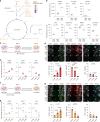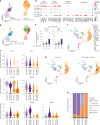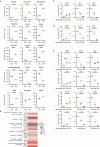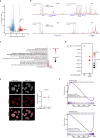α-Ketoglutarate promotes trophectoderm induction and maturation from naive human embryonic stem cells
- PMID: 40269259
- PMCID: PMC12081308
- DOI: 10.1038/s41556-025-01658-1
α-Ketoglutarate promotes trophectoderm induction and maturation from naive human embryonic stem cells
Abstract
Development and lineage choice are driven by interconnected transcriptional, epigenetic and metabolic changes. Specific metabolites, such as α-ketoglutarate (αKG), function as signalling molecules affecting the activity of chromatin-modifying enzymes. However, how metabolism coordinates cell-state changes, especially in human pre-implantation development, remains unclear. Here we uncover that inducing naive human embryonic stem cells towards the trophectoderm lineage results in considerable metabolic rewiring, characterized by αKG accumulation. Elevated αKG levels potentiate the capacity of naive embryonic stem cells to specify towards the trophectoderm lineage. Moreover, increased αKG levels promote blastoid polarization and trophectoderm maturation. αKG supplementation does not affect global histone methylation levels; rather, it decreases acetyl-CoA availability, reduces histone acetyltransferase activity and weakens the pluripotency network. We propose that metabolism functions as a positive feedback loop aiding in trophectoderm fate induction and maturation, highlighting that global metabolic rewiring can promote specificity in cell fate decisions through intricate regulation of signalling and chromatin.
© 2025. The Author(s).
Conflict of interest statement
Competing interests: M.V.-A. is CEO of MoleQlar Analytics GmbH. The University of Copenhagen has filed patent application EP24163585.3 describing the use of dm-αKG enhancing trophectoderm quality. J.J.Z. and K.V.-N. are the inventors of this patent. All other authors declare no competing interests.
Figures















Similar articles
-
α-Ketoglutarate Accelerates the Initial Differentiation of Primed Human Pluripotent Stem Cells.Cell Metab. 2016 Sep 13;24(3):485-493. doi: 10.1016/j.cmet.2016.07.002. Epub 2016 Jul 28. Cell Metab. 2016. PMID: 27476976 Free PMC article.
-
Intracellular α-ketoglutarate maintains the pluripotency of embryonic stem cells.Nature. 2015 Feb 19;518(7539):413-6. doi: 10.1038/nature13981. Epub 2014 Dec 10. Nature. 2015. PMID: 25487152 Free PMC article.
-
PRC2 specifies ectoderm lineages and maintains pluripotency in primed but not naïve ESCs.Nat Commun. 2017 Sep 22;8(1):672. doi: 10.1038/s41467-017-00668-4. Nat Commun. 2017. PMID: 28939884 Free PMC article.
-
Unlocking trophectoderm mysteries: In vivo and in vitro perspectives on human and mouse trophoblast fate induction.Dev Cell. 2024 Apr 22;59(8):941-960. doi: 10.1016/j.devcel.2024.03.029. Dev Cell. 2024. PMID: 38653193 Review.
-
The molecular signature of muscle stem cells is driven by nutrient availability and innate cell metabolism.Curr Opin Clin Nutr Metab Care. 2018 Jul;21(4):240-245. doi: 10.1097/MCO.0000000000000472. Curr Opin Clin Nutr Metab Care. 2018. PMID: 29697538 Review.
References
-
- Anani, S., Bhat, S., Honma-Yamanaka, N., Krawchuk, D. & Yamanaka, Y. Initiation of Hippo signaling is linked to polarity rather than to cell position in the pre-implantation mouse embryo. Development141, 2813–2824 (2014). - PubMed
-
- Niwa, H. et al. Interaction between Oct3/4 and Cdx2 determines trophectoderm differentiation. Cell123, 917–929 (2005). - PubMed
MeSH terms
Substances
Grants and funding
- R345-2020-1497/Lundbeckfonden (Lundbeck Foundation)
- R380-2021-1519/Lundbeckfonden (Lundbeck Foundation)
- 101077271/EC | EU Framework Programme for Research and Innovation H2020 | H2020 Priority Excellent Science | H2020 European Research Council (H2020 Excellent Science - European Research Council)
- 2016-01919/Vetenskapsrådet (Swedish Research Council)
- S16-0039/Sveriges Läkarförbund (Swedish Medical Association)
LinkOut - more resources
Full Text Sources

